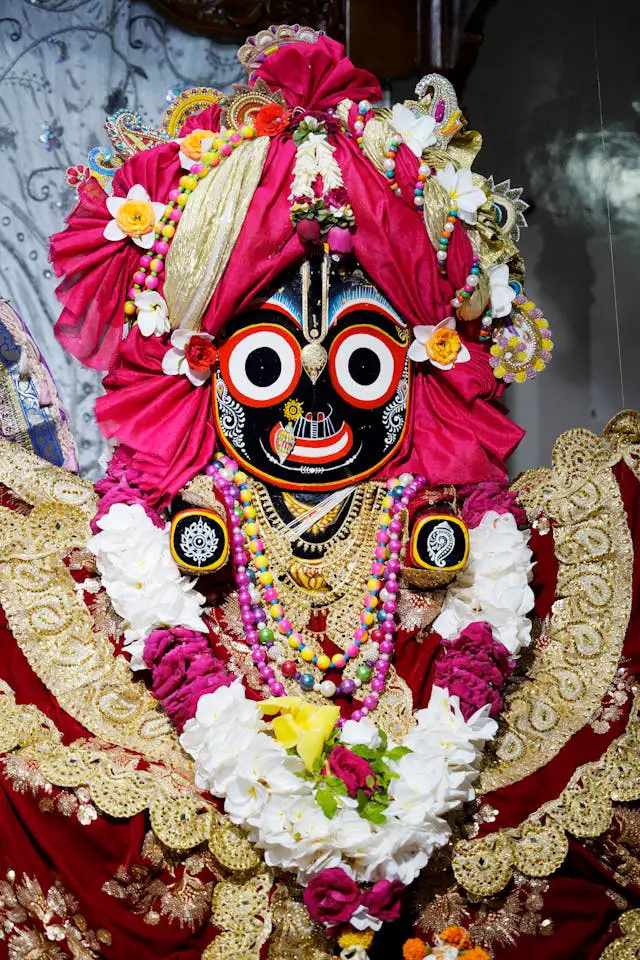May 18, 2024
We hope you enjoy our articles. Please note, we may collect a share of sales or other compensation from the links on this page. Thank you if you use our links, we really appreciate it!
Today I attended an event at Jacksonville beach. The event was called Festival of Chariots, organized by International Society for Krishna Consciousness (ISKCON). The coordinator of the event announced that they have been doing this event in the city for about the last 20 years. In my case, I had the first opportunity to attend the event in 2022, and it was my second opportunity.
The event celebrates Lord Jagannath (‘Jagannath’ is a combination of two words – Jagat which means universe and Nath which means Lord or God, hence Jagannath literally means Lord of the Universe). The original statue of Lord Jagannath and the temple dedicated to him is in the city of Puri, in Odisha state of India. Perhaps a pleasant coincidence, I was born and brought up in this state, and as a child I had occasions to visit the temple of Lord Jagannath. Historians debate about the origin of the temple, but there is unanimity that it was established hundreds of years ago. There is vast literature on Jagannath, folklore about the Lord, and in the Hindu religion the Lord has a preeminent place as the image of Vishnu. There are innumerable stories how the Lord shaped the daily lives of the people of Odisha and the world by taking human forms, how the Lord broke social customs and traditions to help his devotees, and how the Lord imparted wisdom to people in various ways perhaps inconceivable to human understanding.
Every year, the statue of the Lord is taken in a procession, famously known as Ratha Yatra. The English word ‘juggernaut’ came from ‘Jagannath’, particularly in the context of the massive chariot of the Lord, pulled by hundreds of thousands of devotees. Though in an apparent form, the chariot festival looks like a huge event of human celebration in which people across divides pull the chariot of the Lord, from a spiritual perspective it means that before the Lord all are equal, and everyone has the equal right to carry the Divine in their hearts and minds.
Coming back to the event in Jacksonville – hundreds of people joined the festival at the beach. There was delicious food freely available for the people. I relished the food. The delicious food – quinoa, vegetables, sweet dishes – combined with the breeze from the Atlantic ocean, spiritual songs played and performed on the stage, created a serene, and divine, atmosphere. The organizer of the event happily announced the names of the people who contributed to the event. The mayor of Jacksonville beach also spoke a few words.
I would particularly like to mention the Odissi dance performed by the well-known artist Sujata Mohapatra and her group. To give a brief background of the dance – it originated in Odisha, and originally the dance was performed before Lord Jagannath. It is one of the classical dances that originated in India. In this dance, the dancer through various expressions narrates the story from Hindu epics and scriptures. Mohapatra in one of her dances narrated three stories in which Lord Vishnu rescues his devotees from various dangers – in the first case, the elephant whose trunk was captured by a crocodile while the elephant was drinking water, in the second case, the Lord supplying clothes (saree, worn by sections of Indian women) to Draupadi in Mahabharata when she was insulted in the royal court by Dhushasan, and in the third case, the Lord takes the Narasingha Avatar (the reincarnation of the Lord as a creature in which he was half lion and half human) to save his devotee Prahlada and to kill his father Hiranyakashypu. The song and stories in it were not new to me – they are part of popular folklore in Odisha, and as a child I listened to the song many times. The song, in Odia language, starts with these words, ‘aahe nila shaila prabala matta barana…’
Going to the festival today was a kind of going back, at least in memory, to my childhood and teenage days, when I was in Odisha, listening to the Bhajans (devotional prayers) on Lord Jagannath. The song I referred to in the last paragraph, on which dance was performed by Mohapatra, was written by a Muslim saint, Salabega in the early 17th century. Salabega wrote many beautiful poems on Lord Jagannath. As he was a Muslim, he was not allowed by the priests of the temple to go inside and see the statue of the Lord. The story goes like this – on the day of the chariot festival when the statue of the Lord was taken out of the temple to be placed on the chariot, the statue did not go to the chariot despite all the efforts of the people carrying the statue. Only after Salabega arrived and saw the statue, the statue became light and the people could easily carry it to the chariot. This is one of many stories revolving around Lord Jagannath and his devotees. The poems of Salabega reflect this gracious nature of the Lord, and in all his poems one could feel the heart-rending prayer that despite his religion, despite all the barriers he had to confront, nothing could separate him from his Lord. Salabega in all his poems expressed gratitude to the Lord – he sets a perfect example for a spiritual seeker who thinks that because of obstacles/barriers he cannot realize Divine in his life. Salabega exhorts this frustrated spiritual seeker by providing his own life as an example.
As I was watching the Odissi dance narrating the song by Salabega, I almost lost the sense of time and space, moved to that divine and optimistic thinking that Salabega, the devotee, and Lord Jagannath, the Lord of the Universe, were very much present there at the Jacksonville beach watching us watching the beautiful lila of the Supreme…



